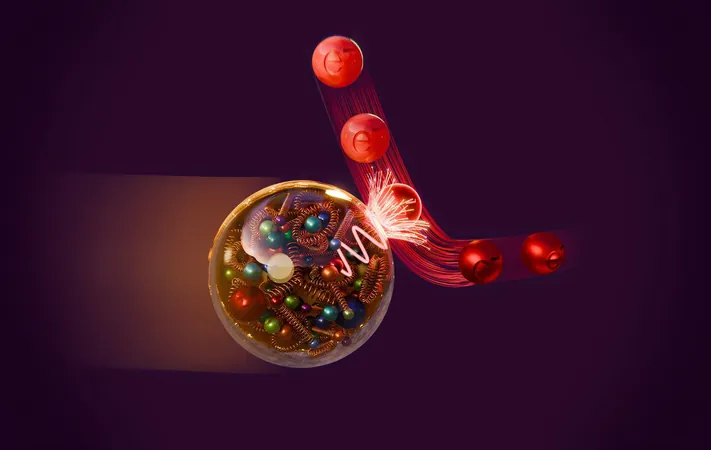
Vancouver Island's Salmon Comeback: A Glimmer of Hope Amidst Uncertainty
2024-12-04
Author: Emma
Overview of Salmon Return on Vancouver Island
This year’s salmon return on Vancouver Island is shaping up to be one of the best in two decades, a notable turn of events in the ongoing struggle to sustain fish populations in the region. Greg Taylor, a senior fisheries advisor with the Watershed Watch Salmon Society, has characterized this season as 'certainly average to above average' when compared to the last 15 years.
Encouraging News from Hatcheries
The encouraging news comes from various B.C. salmon hatcheries, reportedly experiencing their most fruitful returns in a decade. 'Across species and populations, we’ve seen good returns,' Taylor noted. East Vancouver Island has demonstrated impressive returns of chum and coho salmon, while the west coast has recorded healthy sockeye numbers.
Resurgence of Steelhead Population
A particularly exciting revelation includes the resurgence of the steelhead population, which had previously been deemed at risk of collapse. Peter McCully, a veteran biologist with the Goldstream Hatchery in Greater Victoria, expressed his enthusiasm: 'In the last few years, [chum salmon] have been suffering from changing ocean conditions, so we were apprehensive. However, this year, we've exceeded expectations.' Initially anticipating a return of 15,000 chum, the hatchery welcomed over 20,000 fish, and the also harvested approximately 1,800 coho—numbers McCully has termed 'really significant.'
Speculative Factors Behind the Spike
Despite this hopeful scenario, experts remain puzzled about the factors behind this spike in returns. Taylor attributed the improving spawning numbers to favorable conditions in the Salish Sea, with significant migrations of chinook and coho salmon. However, experts warn that current observations remain speculative at best, as numerous variables influence fish populations.
Impact of Climate Patterns
One contributing factor could be a shift in climate patterns—from an El Niño to a La Niña cycle—each bringing distinct impacts to the marine ecosystem. La Niña's cooler, nutrient-rich waters provide a more supportive environment for salmon, unlike the warmer waters that characterize El Niño events.
Reduction of Hatchery Fish
In addition to climate patterns, it appears the reduction of hatchery-raised pink and chum salmon from Alaskan and Japanese sources this year may have benefited B.C.'s wild salmon populations, as fewer hatchery fish to compete against could be a crucial factor in this year’s success.
Human-Induced Threats to Salmon
However, while the marine environment offers some encouragement for salmon populations, the specter of human-induced threats looms large. 'Climate change continues to threaten salmon habitats,' Taylor cautioned, noting the devastating impact last summer's droughts had on essential spawning streams throughout the province. As the rivers swell again with fall rains, the salmon face their final migration—a critical journey that could be jeopardized if drought conditions recur in the coming years.
Challenges from Human Activities
Taylor warns of the various human activities—logging, urban development, and mining—putting additional pressure on salmon populations and their habitats. These silver fish, reliant on both freshwater environments and oceanic ecosystems, face a complex web of threats exacerbated by climate change.
A Note of Hope
As Taylor and experts acknowledge the ongoing challenges, they offer a note of hope. Drawing from decades of experience, Taylor believes it's still possible to reverse some of the troubling trends, advocating for a combination of carbon emission reductions and local habitat restoration to create salmon-friendly environments. Moreover, collaborations with First Nations, who bring a unique perspective to salmon management, could also play a vital role in shaping a better future for B.C. salmon.
Conclusion
As the province navigates the mysteries of the ocean, the return of salmon this year stands as a beacon of resilience—and a call to action—underscoring the complex yet vital relationship we share with this crucial species. The clock is ticking, and the strategies we implement today could determine the fate of salmon for generations to come.









 Brasil (PT)
Brasil (PT)
 Canada (EN)
Canada (EN)
 Chile (ES)
Chile (ES)
 España (ES)
España (ES)
 France (FR)
France (FR)
 Hong Kong (EN)
Hong Kong (EN)
 Italia (IT)
Italia (IT)
 日本 (JA)
日本 (JA)
 Magyarország (HU)
Magyarország (HU)
 Norge (NO)
Norge (NO)
 Polska (PL)
Polska (PL)
 Schweiz (DE)
Schweiz (DE)
 Singapore (EN)
Singapore (EN)
 Sverige (SV)
Sverige (SV)
 Suomi (FI)
Suomi (FI)
 Türkiye (TR)
Türkiye (TR)